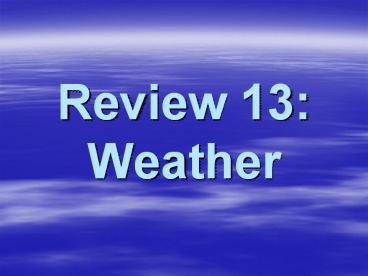Review 13: Weather - PowerPoint PPT Presentation
1 / 16
Title:
Review 13: Weather
Description:
Review 13: Weather Meteorologist scientists who study the weather. What direction do most weather systems travel in the U.S.? Review 13: Weather 2. – PowerPoint PPT presentation
Number of Views:387
Avg rating:3.0/5.0
Title: Review 13: Weather
1
Review 13 Weather
2
Review 13 Weather
- Meteorologist scientists who study the weather.
- What direction do most weather systems travel in
the U.S.?
3
Review 13 Weather
2. Humidity the amount of water vapor in the
air. ? Determines whether precipitation will
fall The higher the humidity, the more likely it
is there will be precipitation. 3. Water cycle
drives the Earths weather
How many types of precipitation can you name?
condensation
condensation
precipitation
transpiration
evaporation
runoff
ground water
water
4
Review 13 Weather
3. Air pressure the weight of all the air
molecules in an area. 4. Barometric pressure
air pressure caused by the weight of the air.
5
Review 13 Weather
5. High-pressure system when cold air sinks to
the ground, warms up, and absorbs water vapor,
causing sunny skies.
6. Low-pressure system when warm air rises
higher in the sky, causing water vapor to cool
and form clouds and precipitation.
Predict what will happen if a high-humidity air
mass located over an ocean moves inland and up a
mountain slope. Why do you think so?
6
Review 13 Weather
- Cirrus highest clouds
- bring fair weather
Cumulus bright white wads of cotton seen with
fair weather
7
Review 13 Weather
Stratus form gray sheets that spread across the
sky Bring heavy mist and snow or drizzle
- Cumulonimbus largest clouds. Bring heavy rain,
high - winds, hail and tornadoes.
Describe the clouds you see outside. Do they fit
any of the categories?
8
Review 13 Weather
7. Hail when a raindrop freezes and forms an
icy ball before falling to the ground.
8. Sleet when a raindrop falls from a cloud and
passes through below-freezing air making a slushy
blob.
9. Snow when ice crystals form in clouds and
fall to the ground without melting.
9
Review 13 Weather
- Make a prediction. What kind of precipitation
will fall if there are - Below-freezing temperatures in the clouds
- Temp. barely above freezing on the ground?
- Describe the air temperature, precipitation,
winds, and humidity during - Winter? Spring?
- Summer? Fall?
10
Review 13 Weather
- Wind speed is described in miles per hour.
- Wind direction is the direction from which the
wind blows. - A north wind comes from the north.
The tail points to where the wind is coming from.
The barbs on the tail show the speed of the wind.
More barbs faster wind
The dot points to the direction the wind is going.
11
Review 13 Weather
- Tools to gather data about the weather
- Thermometer measures temperature
- Anemometer measures wind speed
12
Review 13 Weather
- Tools to gather data about the weather
- Rain Gauge measures the amount of precipitation
- Barometer measures air pressure
- Weather Vane
- indicates wind direction
13
(No Transcript)
14
Review 10 Weather
- Tornado a small storm that forms funnel clouds
of powerful winds, sometimes topping 300 miles
per hour. - Thunderstorm a large storm bringing violent
winds, heavy rain and lightning.
15
Review 10 Weather
- Blizzard a strong winter storm that brings high
winds, very cold temperatures and heavy snow. - Hurricane a severe tropical storm that brings
strong, destructive winds and tidal surges.
16
Review 10 Weather
- Fronts lines that connect a very large mass of
air having the same temperature, pressure and
moisture.
Warm front front of a warm air mass. Brings
steadier, lighter precipitation. Cold front
front of a cold air mass. Brings a drop in
temperature and stormy weather.































